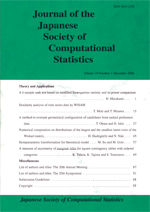Volume 29, Issue 1
Displaying 1-3 of 3 articles from this issue
- |<
- <
- 1
- >
- >|
Theory and Applications
-
2016Volume 29Issue 1 Pages 1-25
Published: December 20, 2016
Released on J-STAGE: October 21, 2017
Download PDF (2041K) -
2016Volume 29Issue 1 Pages 27
Published: December 20, 2016
Released on J-STAGE: October 21, 2017
Download PDF (1708K) -
2016Volume 29Issue 1 Pages 29-54
Published: December 20, 2016
Released on J-STAGE: October 21, 2017
Download PDF (4037K)
- |<
- <
- 1
- >
- >|
